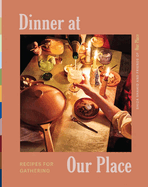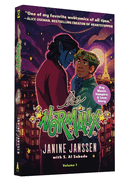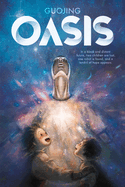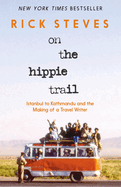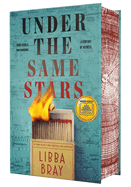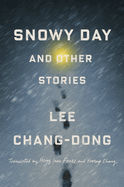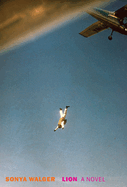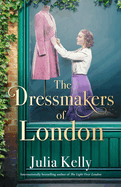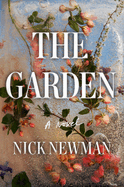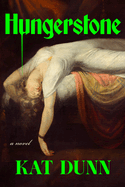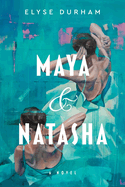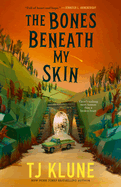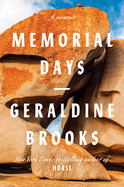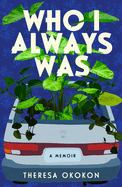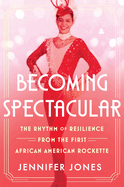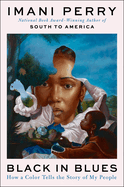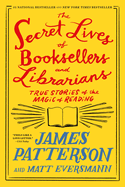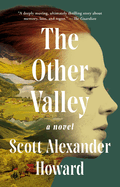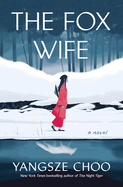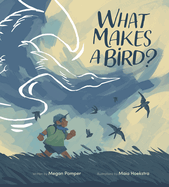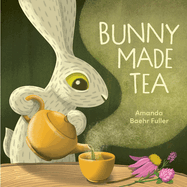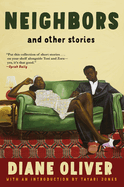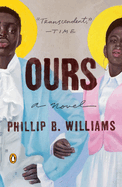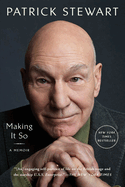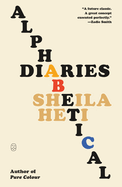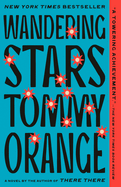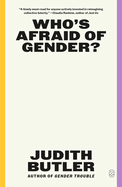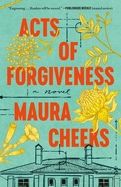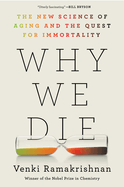Friday, February 21, 2025
Among this week's reading recommendations are encouraging examples of how this great big planet can feel so much less lonesome and scary through the power of human interaction. Seasoned travel expert Rick Steves grants readers passage through his globetrotting origins in the "terrifically fun" memoir On the Hippie Trail, culled from the journal he kept on his 1978 adventure from Istanbul to Kathmandu. In Dinner at Our Place, Shiza Shahid and 11 other cooks bring home inspiration that "spans the world just as it spans the seasons" while reminding us just "how important gathering over lovingly prepared food can be, as a source of connection and joy." In the "spectacular" Oasis, Chinese Canadian graphic novelist Guojing depicts the "unbreakable familial bonds" that emerge for a pair of siblings who find a discarded robot to parent them while their mother works far away.
In The Writer's Life, translator Heinz Insu Fenkl outlines his long relationship with Lee Chang-dong's fiction and unpacks some of the Korean political upheavals that inspired the stories collected in the breathtaking Snowy Day and Other Stories.
Snowy Day and Other Stories
by Lee Chang-Dong, transl. by Heinz Insu Fenkl and Yoosup Chang
Before he became a revered film auteur, Lee Chang-dong was a teacher and writer who published his first short story, "War Trophy," in 1983. That and six additional stories compose his breathtaking first collection published for English-language readers in the U.S., Snowy Day and Other Stories, fluidly translated from the Korean by novelist and academic Heinz Insu Fenkl and Fenkl's former student, Yoosup Chang. Each of Lee's deeply introspective narratives moves between its characters' pasts and their present moments, repeatedly underscoring the consequential connections between the two, both personally and historically. Though some characters make monumental public gestures--protests, grandstanding, self-immolation--most of Lee's protagonists are just trying to survive.
Readers already familiar with Lee's uncanny ability to create precise yet multilayered film imagery will detect that impressive skill in these pages. In the titular story, about a young soldier enduring military conscription, the simple observation that "the snow has stopped falling" becomes rife with poignant meaning about historical consequences, failed connections, moments of inhumanity, and unbearable disappointment. In "Fire & Dust," a taxi driver responds, "It's only the precious kids who die" to news about the death of a student protestor, unaware that his passenger's young son died one year prior. The title of the story "There's a Lot of Shit in Nokcheon" is both observation and prophecy about an unexpected temporary reconciliation between estranged brothers.
Fenkl, in a translator's note, highlights the timelessness of Lee's "masterful" stories: they "come to us when we are experiencing our own volatile times." That recognition, that empathy, should turn aficionados of Lee's films into literary admirers, deservedly expanding his international presence. --Terry Hong
Discover: Internationally lauded filmmaker Lee Chang-dong makes his translated literary debut with a powerful collection of seven timeless narratives in Snowy Day and Other Stories.
Lion
by Sonya Walger
Oxford-educated actress Sonya Walger's stunning debut novel, Lion, is a first-person narrative of an unnamed daughter captivated by her absentee Argentinian father. The father, also unnamed, leaves lovers and daughters strewn behind him across several continents as he chases adrenaline. He's a race-car driver, skydiver, a cocaine user, and, for a time, a prisoner. He seems to have either too much money or none at all.
Walger writes about the narrator's origins: a whirlwind romance between her 18-year-old, inexperienced English mother and her father, newly returned to Madrid from a dubious venture in the Democratic Republic of the Congo. Five years later, her father is a broke mooch who abandons his young wife and child for other pursuits. Although this seems to be his modus operandi, the women in his orbit are as enthralled with him as the narrator. "I have never pushed my father's hands away, I have only ever reached for them," she states, though she could be speaking for any of the women in the novel. Indeed, the entire book reads like an account of reaching for someone just beyond grasping.
Despite understanding the destruction that comes with reaching for this unavailable man, Walger employs hypnotic prose that makes it impossible for readers to look away. She succeeds at this while also keeping the novel's sense of time fluid, sometimes writing from an adult perspective, when the narrator has two children, a husband, and a life and career of her own; other times, she writes from the narrator's childhood perspective. The portrait Walger creates of the father is complex, despite his despicable traits, which is a testament to Walger's observation of humanity. --Nina Semczuk, writer, editor, and illustrator
Discover: In this debut novel by actress Sonya Walger, a daughter traces her enthrallment with her spendthrift rogue of a father, who defies some clichés and falls deliciously, horribly, into others.
The Dressmakers of London
by Julia Kelly
Julia Kelly (A Traitor in Whitehall; The Last Garden in England; Betrayal at Blackthorn Park) crafts an intricate narrative about sisterhood, wartime, and the complications of family secrets in her historical novel The Dressmakers of London. Kelly's novel follows estranged sisters Sylvia and Isabelle "Izzie" Shelton, who reluctantly band together to steer their family's dress shop through the challenges of World War II after their mother's death.
Izzie, a talented seamstress and designer, has always loved the dress shop, while Sylvia--whose talents lie more in accounting--never felt at home there. After Sylvia married a wealthy doctor, the sisters' once-strong relationship was shattered. But when their mother leaves them the shop as a joint inheritance and Izzie gets called up to the Women's Royal Navy Service, Sylvia steps in to run the business and finds herself relishing the sense of purpose and accomplishment it brings. As Izzie's military service opens her eyes to life beyond London, the sisters begin exchanging letters, tentatively opening up to each other about their hopes, fears, and old wounds from the years they spent apart.
Kelly stitches numerous period details into her narrative, including meticulous information about pleats, buttons, and other aspects of fabric rationing. Sylvia's idea for a fashion show featuring London designers and the new "utility clothing" brings the sisters closer, even as they share difficult memories that threaten their fragile new bond. While the dresses will be a treat for fashion lovers, the heart of the novel is its sensitive exploration of the tangled relationship between the sisters and the fresh beginnings that lie ahead for them both. --Katie Noah Gibson, blogger at Cakes, Tea and Dreams
Discover: Julia Kelly's historical novel stitches together wartime fashion, the challenges of fabric rationing, and the tangled relationship between two estranged sisters.
The Garden
by Nick Newman
Nick Newman's The Garden is a shape-shifting novel, an enigmatic fable that twists slowly into a more sinister dystopian narrative with a surprising turn at the end. The questions it asks and the hard truths its protagonists turn away from will keep readers intrigued.
Evelyn and her younger sister, Lily, have lived in the garden all their lives, more or less. They remember little from before, although in the early years there were parties, their father holding court, their mother overseeing. Then the people went away, and the gates were locked, as were the doors to the bulk of the sprawling house. The sisters live now out of the kitchen, and the garden provides everything they need and nothing is expected to change--until it does.
The sisters haltingly identify the creature that appears in their kitchen, stealing their honey, as a boy. The boy is unknown and therefore unsafe, a curiosity and a threat. As they wrestle with this new challenge in their long-immutable garden, the sisters face new choices and turn against each other in new ways.
Newman's gifts lie in the quiet accumulation of his novel's unsettled atmosphere. The garden provides food, sustenance, and floral beauty; it is also constantly threatened by dust storms capable of burying the known world. This parable of change probes the promises and terrors of personal choice. "The vagueness of their mother's threats had made a blank space... and only now was Evelyn realizing that she and her sister saw that blankness quite differently. It excited Lily. It terrified Evelyn." The dystopia it represents may be more real than readers originally understand. --Julia Kastner, blogger at pagesofjulia
Discover: This eerie, thought-provoking novel combines sisterly love and end-of-the-world horrors in an unforgettable pairing.
Hungerstone
by Kat Dunn
British fantasy novelist Kat Dunn crafts a sensuous, bloodthirsty delight in Hungerstone, a twist on the classic vampire tale Carmilla, set during the Industrial Revolution.
Lenore works hard at being a good wife to the handsome and wealthy steel tycoon Henry. This includes staying collected and well-kept, and never asking too many questions, even as he becomes increasingly cold and secretive. But on the way from London to their countryside estate, a carriage accident throws the enigmatic and alluring Carmilla into their paths. As Lenore's household nurses Carmilla back to health, Lenore comes to recognize the woman as a vital, manipulative creature. As Carmilla awakens a new rage and hunger inside Lenore, local girls begin dying. And soon, Lenore, too, begins developing a taste for blood.
Dunn excels at capturing the classic gothic atmosphere of her setting. Through thick drapes and misty moorlands, Lenore's first-person voice, which starts strained with care and reserve, becomes increasingly untethered. While Carmilla has her own appeal, it is Lenore and her unraveling internal monologue that really seduce readers. Her raw desire and ferocity that ultimately burst through feel more like a relief than a sign of devastation.
Dunn isn't shy, either, about digging into the dual gore and heated sexuality underlying Lenore's world. After an accident at Henry's factory, for example, one worker is left with a piece of machinery "wedged under his cheekbone, and his tongue laps at the blood filling his throat." In this truly disturbing rendering of violence, it becomes clear that Henry's world of industry and capitalist ambition is the true horror story, a nightmare of "blood and metal merging." --Alice Martin, freelance writer and editor
Discover: Kat Dunn's Hungerstone is an atmospheric, blood-drenched, feminist twist on classic vampire tropes, a sapphic delight and industrial horror story.
Maya & Natasha
by Elyse Durham
Elyse Durham's poignant debut novel, Maya & Natasha, follows the intertwined stories of the titular twin sisters, born on the eve of the siege of Leningrad to an unwed ballerina mother who dies soon after. Raised by their mother's dear friend, Katusha, both girls spend their childhoods studying at the Vaganova Ballet Academy, the prestigious Soviet ballet school their mother also attended. But as they grow into teenagers, their smooth pas de deux develops a hitch in its rhythm. When the girls, at age 16, learn that the state will not allow two members of the same family to leave the country together, they realize the implications for their burgeoning ballet careers. Soon afterward, a terrible betrayal fractures their relationship entirely, leaving them to build separate lives. The dance of the following decades forms the centerpiece of Durham's narrative, as she explores how the sisters--even from thousands of miles apart--manage to shape one another's lives.
Durham draws the harsh realities of Soviet life in sharp relief: the pervasive grayness of buildings, clothes, and spirits is only occasionally relieved by the color and light found in the ballet. Natasha tests the boundaries of teenage love and rebellion against the state, and Maya struggles with the pain of living in her sister's shadow. Durham explores the themes of freedom, loyalty, artistry, and motherhood, as well as the fundamental bond that ties the sisters together even after their cataclysmic break.
Heartrending, elegantly told, and full of fascinating detail about the worlds of professional dance and Soviet-era daily life, Durham's debut is a stunning ballet of love, loss, and unbreakable loyalty. --Katie Noah Gibson, blogger at Cakes, Tea and Dreams
Discover: Elyse Durham's elegant debut follows the intertwined stories of twin sisters born under the Soviet regime as they navigate love, betrayal, and the world of professional ballet.
Science Fiction & Fantasy
The Bones Beneath My Skin
by TJ Klune
A journalist picking up the wreckage of his life blunders into the adventure--and love--of a lifetime in The Bones Beneath My Skin, a witty, swoony soft sci-fi thriller by TJ Klune (In the Lives of Puppets).
The year is 1995, and Nate Cartwright has lost his job at a major Washington, D.C., newspaper and returned to his family's cabin in remote Herschel Lake, Ore., to evaluate his options. He does not expect to find squatters at the cabin: a huge Marine named Alex, who puts a gun to Nate's head, and a little girl named Artemis Darth Vader. Nate has no idea what to make of the taciturn, overprotective man and his tiny ward, who has never eaten bacon, makes pronouncements such as, "I like money. It smells weird," and overindulges in Louis L'Amour novels. But when powerful forces come for Art, who is revealed to be far more than an ordinary child, Nate's concern for her and his growing connection with Alex drive him to risks beyond measure and a love greater than anything he could have ever imagined.
This independent-minded novel reads like an action-adventure, romance, and road-trip narrative combined. Originally self-published in 2018, the novel's absurd humor, clever banter, and opposites paired as love interests foreshadow elements of Klune's breakout hit, The House in the Cerulean Sea. This delightfully different story of danger, loneliness, and making "a home out of a place where one should not exist" combines the cozy and the perilous into something a little bit like magic. --Jaclyn Fulwood, blogger at Infinite Reads
Discover: A down-on-his-luck journalist goes on the run with a gruff Marine and an extraordinary little girl in this witty, swoony soft sci-fi thriller by TJ Klune.
Graphic Books
Les Normaux: Volume One
by Janine Janssen and S. Al Sabado
Set in a parallel world inhabited by paranormal creatures and magical humans, Les Normaux by Janine Janssen with S. Al Abado contains a cornucopia of diverse queer love stories. Compiled from a popular Webtoon comic, this first volume is sure to create new fans of the sweet and heartwarming series, which is drawn in a lush, colorful style that neatly balances realistic figures with cartoonish flourishes.
Sébastien was raised in the human world by non-magical parents and recently moved to the magical world with his magical aunt's help. Though he's awkward and afraid of meeting new people, he impulsively visits a queer bar one night and kisses a super-hot vampire who turns out to be his neighbor Elia. Elia is not as suave as Sébastien thinks, however, and the two dance around each other, longing for more than friendship but unsure how to make that happen or if their feelings are reciprocated. It doesn't help that Sébastien's homework accidentally turns Elia's hand pink, and neither is sure whether they're spending time together to fix the mistake or out of genuine desire. Meanwhile, Sébastien is befriended by two men also taking magic classes, and Elia's group of theater friends have their own romantic and sexual adventures, especially Ronnie, who's great at giving dating advice but unprepared when it's her own heart on the line.
The creators' skill in setting exactly the right tone for each moment is perfectly encapsulated in a sequence depicting a usually cynical character's intense first date; emotion pumps off the pages solely via images. Scenes of raw vulnerability and laugh-out-loud humor beautifully render the complexity of developing adult relationships both romantic and platonic. --Dainy Bernstein, freelance reviewer
Discover: In this gorgeous graphic novel, humor, raw emotion, and sizzling romance come together for a sensational queer paranormal about love and friendship.
Food & Wine
Dinner at Our Place: Recipes for Gathering
by Shiza Shahid and Friends of Our Place
Shiza Shahid, CEO of the viral Our Place cookware brand, invites home cooks into an "ideal world" where we're all "throwing dinner parties at least once a month" in Dinner at Our Place: Recipes for Gathering. With input from 11 additional home cooks (many of whom are chefs, but all of whom are known as "host, curator, gathering specialist"), the recipes here are combined with menus, conversation topics, bar suggestions, tablescapes, plating advice, and playlist recommendations to offer a year's worth of dinner party ideas for readers, one for each month.
The food in Our Place spans the world just as it spans the seasons: Shahid shares her recipe for chana masala, explaining why the traditional comfort food in Pakistan makes it onto her January entertaining menu. Maryah Ananda, in presenting her spring-themed menu for April, recalls the Laotian feasts of her childhood: "They taught me that food is a language everyone speaks, and it's my favorite one to communicate in." For August, Devonn Francis lays out an immersive food experience in his "Reimagined Caribbean Feast," with dishes like Jerk Shrimp Skewers and Sweet Star Fruit & Salted Ice Cream. Angel Dimayuga conjures a stoop party in October with a potion-themed drinks bar and creepy snacks to accompany.
Individually, each monthly menu offers inspiration and ideas for gatherings large or small, indoors or out, loud or quiet. Collectively, these spreads are a celebration of the "ritualistic reverence" and "generosity" of opening one's home to others. Dinner at Our Place is a reminder of how important gathering over lovingly prepared food can be, as a source of connection and joy. It's a timely invitation to play with new traditions for your people--whoever they may be. --Kerry McHugh, freelance writer
Discover: Foodies with large friend groups, home cooks who may be a bit lonely, and everyone in between is bound to find inspiration in the pages of Dinner at Our Place.
Biography & Memoir
Memorial Days: A Memoir
by Geraldine Brooks
Geraldine Brooks's 10th book, the elegant bereavement memoir Memorial Days, chronicles the sudden death of her husband and her grieving process.
On May 27, 2019 (Memorial Day), Brooks's husband, the author and journalist Tony Horwitz, collapsed while on book tour in Washington, D.C., and couldn't be revived. His cause of death was eventually revealed to be myocarditis, an inflammation of the heart muscles. Brooks learned that he had recently consulted his cardiologist about shortness of breath. She also realized, in hindsight, that he'd become reliant on alcohol and stimulants to keep up a frenetic pace of work.
In alternating chapters, Brooks (Horse; Caleb's Crossing) toggles between the immediate aftermath of her bereavement--breaking the news, dealing with bureaucracy, gathering with family, planning memorial services--and a February 2023 trip to Flinders Island in her native Australia. There she surrendered to the sorrow she'd been suppressing for years, finally allowing herself to relive her shared past with Horwitz: Columbia Journalism School, dicey Middle East correspondent days, and raising their sons on Martha's Vineyard. Though they were secular Jews, Brooks unintentionally observed informal Jewish mourning rituals while on Flinders and also researched their presence in other cultures, including Australia's First Nations people.
Memorial Days gives a keen sense, through its vivid scenes and matter-of-fact tone, of how practical and philosophical matters jostle for position after a death. It courts universality by pondering how to memorialize those who are gone. Based on her own experience of stifling emotions, Brooks advises others to take time to grieve. Her lucid account will attract readers of Joan Didion's The Year of Magical Thinking. --Rebecca Foster, freelance reviewer, proofreader and blogger at Bookish Beck
Discover: Geraldine Brooks's elegant bereavement memoir chronicles the sudden death of her husband, the author and journalist Tony Horwitz, and her delayed grieving process.
Who I Always Was
by Theresa Okokon
Theresa Okokon's wry, poignant memoir-in-essays, Who I Always Was, reflects on being the daughter of African immigrants to the U.S.; her hopeful and often frustrating romantic adventures; and the persistent murkiness surrounding not only her father's death--in Nigeria when Okokon was nine--but also his life. These sharp, insightful pieces detail Okokon's experiences growing up as a Black girl in Wisconsin (and constantly being othered), as well as her mother's attempts to protect and nourish the four children she raised alone after her husband's death. Okokon recounts mazelike conversations with family members about her father, and examines the ways her father's absence has affected her growth and personal identity. "My father's death, quite simply and endlessly complicatedly, is just part of my life," she notes. This paradoxical truth underpins Okokon's narrative: she is and is not a product of her father's death, just as her choices and her adult life are and are not a direct result of her childhood and teenage years.
Elsewhere, Okokon pokes gentle fun at her own teenage rebellion, recounts dating disasters from various eras of her life, and considers her struggle to fully inhabit her own Blackness without apology. She celebrates her deep bond with her immediate family, while also honoring the life she has built apart from them, as a single woman. Who I Always Was is a witty, moving exploration of identity, family secrets, and one woman's search for love and acceptance in all its forms. --Katie Noah Gibson, blogger at Cakes, Tea and Dreams
Discover: Theresa Okokon's wry, moving memoir-in-essays reflects on Blackness, grief, identity, and family secrets after her father's death when Okokon was a child.
Becoming Spectacular: The Rhythm of Resilience from the First African American Rockette
by Jennifer Jones and L.C. Smith
The Radio City Rockettes' shtick has always been uniformity--women of similar heights and weights do synchronized moves in identical costumes--and it wasn't until 1987, after six decades in existence, that New York City's fabled kick line was ready to welcome a dancer with dark skin. That dancer was Jennifer Jones, who told her story for kids in the picture book On the Line, and now she tells it for adults, with brio and humility, in Becoming Spectacular: The Rhythm of Resilience from the First African American Rockette.
Jones, the daughter of an interracial couple, was born in 1967 and raised middle class in New Jersey. As a child, she took tap-dancing lessons, and she realized that the stage was home while performing the jitterbug in her fourth-grade recital. Jones continued to take dance classes into adulthood, and in 1987, she saw an ad in Backstage magazine announcing that the Rockettes (Jones "didn't know who they were") were auditioning dancers. She showed up ("I saw that ethnic minorities were encouraged to attend") and made history.
Becoming Spectacular is a survivor's tale: along with professional disappointments, Jones weathers male predation, a thorny divorce, financial trials, and a medical crisis. The book contains some formulaic writing, but readers will surely be moved by Jones's unstinting honesty, including about the fact that she didn't become a Rockette with intent to blaze a trail: "I couldn't get caught up in the symbolism of what my inclusion meant, because I had a job to do." Becoming Spectacular is a diva-free production. --Nell Beram, author and freelance writer
Discover: Jennifer Jones, the first Black Rockette, tells her story with brio, humility, and unstinting honesty.
History
Black in Blues: How a Color Tells the Story of My People
by Imani Perry
In Black in Blues: How a Color Tells the Story of My People, Imani Perry (South to America) offers haunting reflections on the strong connections between the color blue and the history of Black people. In a lyrical style, she muses about the roles that blue has played: blue, the feeling of sadness; blue, the sound of thoughtful music; blue, the color of beads that enslavers traded for Black lives in the Congo.
As Perry writes, "The association of the color blue with sadness is of English origin. The sound is African-rooted. The color is global." She expertly uses this framework to tell the stories of many Black people, including Liberian settlers, members of the Nation, and Toni Morrison. Perry finds insight in work by people she'd long known about: Rosa Parks and Duke Ellington and W.E.B. Du Bois. This led to discoveries of figures she was less familiar with, such as Jean-Jacques Dessalines, the Haitian revolutionary; Paul Gonsalves, the Cape Verdean American jazz musician; and Andrée Blouin, an extreme rarity: a Black female political activist and anticolonialist leader from the Central African Republic.
Perry's spare and poetic writing powerfully encapsulates history. It also underlines the frequency with which English-language speakers refer to ideas such as black-and-blue bruising, blue-black skin and hair, or the blues music predominantly played by Black musicians.
Black in Blues is sure to appeal to readers who enjoy exploring social justice topics. Perry's blue-tinted history offers a fascinating lens through which to see the world. --Jessica Howard, freelance book reviewer
Discover: In a series of poetic musings, Imani Perry uses the color blue to recount Black history.
Travel Literature
On the Hippie Trail: Istanbul to Kathmandu and the Making of a Travel Writer
by Rick Steves
In 1978, travel pro Rick Steves (Europe Through the Back Door) went on the adventure of a lifetime--overland from Istanbul to Kathmandu. He kept a journal, which he now shares with readers. Through Steves's clear and everyday language, On the Hippie Trail transports readers along with Steves and his travel companion, Gene Openshaw (who assisted in providing photos and editing the journals for publication), across vast scenic landscapes, down bumpy roads, past numerous border checkpoints, and beyond. In the current world of smartphones and constant connectivity, it is a refreshing novelty to witness someone in a land so unlike their own manage with nothing but a backpack, a good attitude, and some glucose biscuits (a favorite, it turns out, of Nepalese monkeys).
Splashed throughout are photographs from the journey and facsimiles of Steves's handwritten journal, allowing readers a peek into the unedited thoughts of the author. Not all fun and games, the adventures include their fair share of bug-infested hotels, sleeping outdoors or in unused train cars, and digestive issues. Still, he paints a rosy and nostalgic picture of his time as a 23 year old, fresh in the world, exploring and learning who he's going to be.
While readers familiar with the author will know him best for his work in Europe, he is equally at ease traversing 3,000 miles through Istanbul, Turkey, Iran, Afghanistan, Pakistan, India, and Nepal. This is not, however, a travel guide, but rather a reminiscence of a time gone by. An excellent airplane book, On the Hippie Trail is perfect for fans of adventuring, seeing the world, and any of Steves's other work. --Alyssa Parssinen, freelance reviewer and former bookseller
Discover: This terrifically fun travel memoir will make even the most homebodied reader consider if they, too, could survive and thrive for months away from home with just a backpack.
Now in Paperback
The Secret Lives of Booksellers and Librarians: Their Stories Are Better Than the Bestsellers
by James Patterson and Matt Eversmann
Of all the dreams in the world, becoming a librarian or bookseller is one of the most common. But what is it about these professions that maintains a hold over communities and the imaginations of individual readers? In The Secret Lives of Booksellers and Librarians, coauthors James Patterson and Matt Eversmann take booklovers into the minds of the people across the United States who give their lives to books--not by writing or producing them, but by putting books into readers' hands (though Judy Blume gives a fascinating look at her transition from beloved author to bookseller).
These librarians and booksellers recount what made them choose their careers, as well as the myriad challenges they face, including book bans, store closings, and the preservation of community lifelines in the face of natural disasters and global pandemics. They provide readers with glimpses into their communities and their schools, and even into places readers might not realize these professionals can be found, such as the jails on Rikers Island in New York City.
They detail why doing the work to connect communities with books that reflect their lives matters beyond the individual reader. Everywhere they are, these librarians and booksellers connect with readers who find themselves in books, for whom the right book might make all the difference. The Secret Lives of Booksellers and Librarians proves that it is not only the spaces of libraries and bookstores that are important but also the people who fill them with the intention of building bigger, wider, and more connected communities. --Michelle Anya Anjirbag, freelance reviewer
Discover: Librarians and booksellers recount why they do what they do, and James Patterson and Matt Eversmann bring their hopes and dreams straight into readers' hands.
The Other Valley
by Scott Alexander Howard
Scott Alexander Howard's first novel, The Other Valley, is a lyrical, thought-provoking coming-of-age story that probes the question of self-determination.
"That fall I was sixteen and the course of my life was ready to be determined. My class had reached the apprenticeship level," at which young people choose a professional path. Odile lives in a village in a valley bookended by villages in valleys identical to hers, with an important difference: to the east lies her village 20 years in the future. To the west, 20 years in the past. The Conseil governs the rare and tightly controlled visits from one valley to another. Coinciding with her bid for a conseiller position, Odile witnesses a visitor from the east. From what she has seen, she understands what is to come, and has the opportunity to influence events--but the Conseil teaches that she must not. Intervention, it is well understood, leads to catastrophe.
At the same time, Odile suddenly finds herself part of a group of friends for the first time: a fivesome of boys and girls her age, all struggling with choices about their future lives, including budding romance. She develops concurrent loyalties to the Conseil and to her friends, and these quickly clash. The nature of the valleys implies preordination, but her actions are her own. What if she could save a life? What if she had to sacrifice her own?
The premise is strikingly unusual and provocative; the climax, after a long, subtle build, is electrifying. With beautiful prose, a compelling protagonist, and serious fodder for thought, The Other Valley is a remarkable debut. --Julia Kastner, librarian and blogger at pagesofjulia
Discover: Alongside her coming-of-age, a teenaged girl must wrestle with when it is appropriate to influence the past and the future in this remarkably imaginative debut.
The Fox Wife
by Yangsze Choo
Yangsze Choo's tantalizing third novel, The Fox Wife, follows Snow, a fox in the guise of a human. She is as dangerous as she is alluring, and she is intent on having revenge on Bektu Nikan, a Manchurian photographer and hunter who killed her daughter. Meanwhile, when a courtesan's frozen corpse is found in an alley in Mukden, 63-year-old Bao Gong is called in to investigate. Bao suspects, from the description, that the man last seen with the dead woman was actually a fox. Bao has a special curiosity about fox tales, having grown up visiting a fox god's shrine with his nanny, and he collects cases that seem to involve fox mischief.
Chapters about Bao's investigation, told in the third person, alternate with Snow's unabashedly feminist first-person narration, creating momentum. While acknowledging the patriarchal norms of that time, Choo expands the sphere of women by granting attention to servants, foreigners, a medium, and the elderly--women looked down on by society. For instance, Tagtaa, a Mongolian concubine's daughter and Bao's childhood friend and crush, becomes a key character. Tagtaa is one of the rare women whose feet were not bound; Snow stands out for the same reason.
As Bao's suspicions start to focus on Snow, their two story lines move ever closer together with mounting suspense. The multilayered details of everyday life in early 20th-century China and the evocative metaphors make for vivid, realistic scene-setting. Choo (The Night Tiger; The Ghost Bride) contrasts that air of realism with delicious hints of the supernatural. Fans of Lisa See and of Téa Obreht's The Tiger's Wife will fall in love with the historical magic and mystery. --Rebecca Foster
Discover: Yangsze Choo's third novel, The Fox Wife, is just as steeped in Chinese folklore as her previous works, this time with a focus on the tantalizing stories related to foxes.
American Mother: A Life Reclaimed
by Colum McCann and Diane Foley
National Book Award winner Colum McCann (Apeirogon; Letters to a Young Writer; Thirteen Ways of Looking) lends his considerable skill to Diane Foley's story in American Mother, a memoir of her experience as the mother of Jim Foley, a journalist held hostage for years before being brutally executed in 2014 by ISIS fighters. The book introduces Foley's distinctive voice, unassuming but insistent, as she reckons with the darkness brought on by hate and evil--and returns again and again to grace and mercy.
Foley's is a faith-filled life, and she makes no secret of her deep commitment to God. But this is no proselytizing narrative, offering instead a look at the astonishing power that comes from seeing the holiness (however that may be defined) of everyone, even those who have committed the most egregious harms. During her improbable meeting with one of the men convicted of her son's murder, she is moved by the picture of his young daughters, and wars within herself: "She understands what he is doing: he is fully invested in humanizing himself. What else did she expect? Even the worst of humans demand a portion of love."
Foley's conversations with this man are written in a close third-person voice, allowing readers to view her actions from an outside perspective. These sections bracket the central narrative, told in first-person with Foley speaking for herself. Though the voices don't blend seamlessly, the overall effect is a powerful examination of unforgivable pain met with extraordinary forgiveness. --Sara Beth West, freelance reviewer and librarian
Discover: American Mother tells Diane Foley's story, a powerful examination of unforgivable pain met with unthinkable forgiveness after the brutal murder of her son, journalist Jim Foley.
The Exvangelicals: Loving, Living, and Leaving the White Evangelical Church
by Sarah McCammon
NPR reporter Sarah McCammon's insightful first book, The Exvangelicals, delves into the past and present of the white American evangelical Christian movement, exploring why younger evangelicals are leaving the church in droves. McCammon, who grew up evangelical in Kansas City, Mo., charts the movement's history, its massive cultural impact, its problematic association with the Republican Party, and some of the ways its younger members are finding spiritual fulfillment elsewhere.
McCammon thoughtfully recounts the potent mix of fear and love that shaped her personal experience with evangelical culture in her youth: the image of God as a stern but loving father, and the contradictions of a church that emphasized salvation by grace, yet imposed many rules on its members (especially women and girls). Through extensive interviews with religious scholars and cultural critics, McCammon traces the movement's rise through the second half of the 20th century and its eventual alliance with the Republican Party.
Though McCammon exposes evangelicalism's weaknesses, she doesn't demonize either the movement or its members: having grown up evangelical, she knows that real community and strong bonds can both support church members and make it harder for them to leave. She also interviews other "exvangelicals" who have left behind the movement's faulty theology but miss their former communities, and are trying to help others wrestling with similar questions.
Incisive, clear, and deeply compassionate, The Exvangelicals is a brilliant critique of a powerful cultural movement, and a moving meditation on loving (and eventually leaving) one's roots. --Katie Noah Gibson, blogger at Cakes, Tea and Dreams
Discover: NPR reporter Sarah McCammon's incisive memoir explores the cultural impact of the American evangelical movement alongside her own complicated story of growing up in it.
Children's & Young Adult
Oasis
by Guojing
Guojing's Oasis, her second graphic novel after The Flamingo, is another spectacular stunner that perfectly balances evocative art with minimal text. In a harsh, barren landscape, JieJie and her younger brother, DiDi, somehow manage to survive alone, buoyed by the promise of reuniting with their mother. Mom is 25 hours away, overworked in a grueling underground factory that builds the AI robots that ensure exclusive Oasis City remains a prosperous, pure paradise.
On DiDi's birthday, the children chase a water-thieving fox into a trash heap, where they discover a discarded robot. JieJie, dragging the main components home, manages to awaken the machine: "Please state your wish," the robot invites. Since DiDi is the birthday boy, he hesitantly reveals, "I... I want... a mom." The children are quickly, utterly enthralled: AI Mom is wondrous--protective, nurturing, unconditionally loving. But what happens when real Mom returns?
Chinese Canadian Guojing dedicates Oasis to "the left-behind children," a disturbing global phenomenon in which children "are left in rural areas while their parents leave to find work in the city." Her close-ups of their young faces are both wrenching and hopeful--they are abandoned, yet they tenaciously trust in their faraway mother. AI Mom is another marvel, her undeniable humanity an emotional oasis for all. The sepia tones dominating Guojing's pages reflect the loneliness of separation, but hints of rose and pink--particularly on faces, hands, and hearts--confirm unbreakable familial bonds. By book's end, the colors gently glow. Admirers (of any age) of Shaun Tan's iconic The Arrival will recognize similar genius here. --Terry Hong
Discover: Guojing's stunning sophomore graphic novel captures an unbreakable bond between children and their parent, despite separation and deprivation.
Under the Same Stars
by Libba Bray
Under the Same Stars is a "tragically romantic" and "romantically tragic" reminder of how people relentlessly "manage to come together and fight toward justice" no matter the era or odds against them. Printz Award-winning author Libba Bray (Going Bovine) masterfully develops a multilayered mystery with lush prose and evocative detail across three timelines.
In 1940s Germany, best friends Sophie, a bookish dreamer, and Hanna, dubbed "The Barbarian" for her pragmatism, work as secret resistance fighters. That they ultimately spared more than 1,000 people from concentration camps is overshadowed by the confusion around the girls' unsolved disappearance. In 1980s West Berlin, picture-perfect American teenager Jenny rebels against parental and political oppression when she meets Lena, her punk-rocker first love, and Frau Hermann, a woman harboring 40 years' worth of secrets. And in 2020, Miles and Chloe, estranged friends reconnecting virtually during the Covid-19 pandemic, are activated by the Black Lives Matter protests at the same time they discover unexpected connections in a puzzling package from Chloe's grandmother.
Bray is no stranger to complex magic systems, developing here a magic that lies in the power of storytelling itself. Varying iterations of "The Tale of the Hare and the Deer," a fable of the author's invention, strategically hide poignant truths until relevant to the plot. Quixotic Sophie finds solace in stories; Hermann believes stories are the "code for survival," an essential tool to process trauma and seek atonement; and Miles and Chloe decode the myth's true meaning, learning how to support and cherish one another while fostering hope for a better future. --Cristina Iannarino, children's book buyer, Books on the Square, Providence, R.I.
Discover: A gripping and complex mystery that spans three timelines about storytelling, resistance, remorse, and reconciliation.
What Makes a Bird?
by Megan Pomper, illus. by Maia Hoekstra
What Makes a Bird? is a wonderfully thought-provoking picture book debut that ruminates on the surprisingly difficult question of how one defines a bird: Is there a single, preferred way, or is a bird, perhaps, more than simply the sum of its parts?
Through a series of well-considered questions, a brown-skinned child wearing a blue cap and kerchief and carrying binoculars tries to understand what, exactly, makes a bird. Is a bird "a bird" because of its feathers? But each feather the child finds on the beach is "not on a bird anymore," so does that make the bird "one part less bird?" Does it make the child holding the feather "one part more bird?" Maybe a bird is a bird because of its beak: there are many kinds of beaks and every bird seems to have one. But if octopi have beaks, does that mean they are birds, too? Readers then begin to reach the crux of the matter, because now the child wonders if being a bird is "all of these things" or "none of them." And, really, who should get to decide?
Megan Pomper's child-friendly, contemplative text encourages scientific, empathetic, and poetic thinking that deeply ponders the essence of bird-ness. Maia Hoekstra's dynamic illustrations use natural tones combined with swirls of bright color as well as close-ups and active angles to create an impressionistic sense of a wide variety of birds and their habitats. Back matter identifies the many species pictured in the book and invites readers to create names for the three made-up birds "from the artist's imagination." What Makes a Bird? is an excellent and accessible meditation on identity. --Lynn Becker, reviewer, blogger, and children's book author
Discover: What Makes a Bird? is an accessible and contemplative picture book which considers how one might define a bird.
Bunny Made Tea
by Amanda Baehr Fuller
One good turn deserves another is the order of the day in the warm, soothing picture book Bunny Made Tea by author/illustrator Amanda Baehr Fuller.
"Bunny wanted tea," so the white rabbit with tall, expressive ears braves a dreary, rainy day to gather a bundle of purple blooms. A curious opossum wanders into Bunny's homey den just as the first cup leaves the yellow teapot. Bunny shares, and Opossum dunks a thirsty snout into the cup with relish, twitching ears wreathed in steam. Bunny peers into the empty pot in consternation as Opossum exits. "Bunny still wanted tea," but a second steeping brings the return of the mooching marsupial with a back full of big-eyed babies. While three of the babies lounge and play, one curiously follows Bunny, who gathers enough tea ingredients for the entire family. Alas, Bunny goes to bed with no tea and dreams wispy dreams of the tea not drunk. A puffy waft of steam the next morning leads Bunny to a fresh pot of tea, and a certain opossum tot watches from out of sight as the hospitable hero finally quenches the tea craving.
Fuller's short sentences make this cozy debut a great choice for sharing with toddlers, and the illustrations and messaging lend enough complexity to inspire rich discussion with preschoolers. Bunny's endearing long-eared shape and bright yellow eyes recall a hollow chocolate bunny, and the baby opossums' oversized heads and curling bare tails add a high squee factor to the proceedings. Rich mossy greens and botanical textures give a sense of softness and natural abundance to this gentle story. --Jaclyn Fulwood, youth services manager, Allen County Public Library
Discover: A rabbit's craving for tea is thwarted by thirsty opossums in this gentle, soothing picture book.
More Paperbacks
The Writer's Life
Heinz Insu Fenkl: Translation as a Kind of Method Acting
 |
|
| Heinz Insu Fenkl (photo: Peter Lueders) |
|
Heinz Insu Fenkl writes and translates across genres. His latest project is Snowy Day and Other Stories (Penguin Press; reviewed in this issue) by lauded Korean filmmaker Lee Chang-dong, which he co-translated with Yoosup Chang. Written in the 1980s, long before Lee became a globally revered auteur, the seven stories here feel just as contemporary almost a half-century later as political upheavals and conflagrations continue across the globe.
Your translator's note reveals the provenance of your 20-year history with Lee's work. Could you share some of that background?
I found Lee's first story, "The Dreaming Beast," by accident because it was in a literary journal that came free of charge with a Korean women's magazine my mother used to buy at the Korean grocery in Marina, Calif. It had that quality of being easy to visualize--something that happens when you get absorbed in a story. When I went to Korea for my Fulbright in 1984, I thought I'd try doing some translation, and that's how I got started with Lee's work. I stopped after a few pages, and then I didn't pick up the story again until the 2007 inaugural issue of Azalea [Korean literature and culture journal published by Harvard's Korean Institute].
Lee was inspired by specific Korean events. Do you think Western readers need to be familiar with that history to appreciate these stories now?
I think readers who already know something about modern Korean history will understand the context of those stories quite well. For Anglophone readers in general, it would probably help if they knew about the events that followed the assassination of Park Chung-hee and the martial law that followed when Park's former general, Chun Doo-hwan, took over. The Gwangju Uprising in 1980 and the massacre of civilians by the Korean military was a major turning point in national sentiment, especially in relation to Koreans' attitudes toward the U.S. The Uprising was part of the democratization movement protesting the authoritarian take-over by Chun, and the leaders of the Uprising had appealed to the U.S. for help. When there was no intervention, they felt betrayed, and the almost universal pro-American attitude that followed the Korean War practically vanished in a few years. The impact of the Gwangju Massacre on Koreans is still profoundly felt today.
Since you grew up in Korea during these dictatorial regimes, was working on these stories triggering for you?
I grew up during Park Chung-hee's administration when the Saema'eul Movement ("New Community Movement") was in full swing. That's when there was a surge of national development of infrastructure and industry at a terrible cost to the environment and to people's lives. I was only a child, so I didn't understand the full political implications, and I was insulated from much of it because I spent most of my time on U.S. military bases and in the camptowns (Bupyeong and Itaewon). I did witness police brutality firsthand. The curfew just seemed to be a fact of life at the time, and I had a cousin who got into trouble for little things like having hair that was too long or for smoking American cigarettes. My mother was a black marketeer, so by association (sometimes helping her), I also saw how things worked with law enforcement on both the Korean and U.S. military sides. That was from the late 1960s into the early 1970s and is part of what I explore in my novel Skull Water.
Lee's stories are set in the early-to-mid 1980s, which would be a decade later, but much of the political climate had not changed. The daily life, and the conditions--political and economic--of postwar Korea also had not changed much. The families in his stories are on the margins of society (usually because some family member is associated with accusations of being a communist sympathizer), and my family was also always on the margins. My mother was also constantly in debt and the houses I lived in were visited regularly by debt collectors, black marketeers, and prostitutes, so the theme of living on the fringes of society resonated very strongly for me.
You're a writer as well as a translator. How different is your process between the two?
I described my translation process as a kind of "method acting" to Lee Chang-dong, and he told me that was the most accurate analogy for it he had ever heard. Before I translate a story or a novel, I read it several times so that I understand the feel, the style, and the tone of the language (since I must re-create an analogous style in English). But that means I also have to immerse myself in the things the story or novel is alluding to (which is why it took me more than a decade to translate Kim Man-jung's The Nine Cloud Dream, a 17th-century Korean novel written in Tang Chinese).
After translating for many years, I discovered that the process in my own writing isn't all that different. I begin by immersing myself in the story (and since so much of my writing is autobiographical, that means in my memories of the past), then I have to convey images and emotions in language. So I realized that I'm also "translating" my own experiences in much the same way in my own writing.
Between my novels Memories of My Ghost Brother and Skull Water, I was engaged primarily in translating and writing about Asian American and Korean literature, so I learned a great deal from writers like Hwang Sun-won, Yi Mun-yol, Pyun Hye-young, and, of course, Lee Chang-dong. All of them have distinct styles, and translating them in many ways was also a process of studying and learning from them. All that experience influenced my own work. What's distinct about Lee's writing for me is that his ability to visualize (the "narratography" of his writing, as I've called it) is very parallel to my own visual imagination. His stories, when I remember them, feel like memories from my own life experience.
How did you and your co-translator Yoosup Chang divide the work?
For the stories we co-translated, Yoosup would do a first draft at the same time I was doing my first draft. He would keep his draft very literal (adding notes for particular difficulties, especially things that needed contextual cues or were figures of speech). Then we would go back and forth editing together until we had a final draft. At that point, I would copyedit it as if it were written in English.
One of the reasons I've worked with Yoosup Chang is that he's a decade or so younger than I am, and he has an excellent command of contemporary colloquial Korean. I'm especially good at translating works that come out of the Japanese colonial era and post-Korean War period because that's the language I heard as a child, which was still being spoken into the early 1970s. --Terry Hong
Book Candy
Book Candy
"When William S. Burroughs appeared on Saturday Night Live: his first TV appearance (1981)," courtesy of Open Culture.
---
Joan Didion's official archive is going on view at the New York Public Library next month, Gothamist reported.
---
Mental Floss highlighted "11 people whose names became adjectives."
Rediscover
Rediscover: Geoff Nicholson
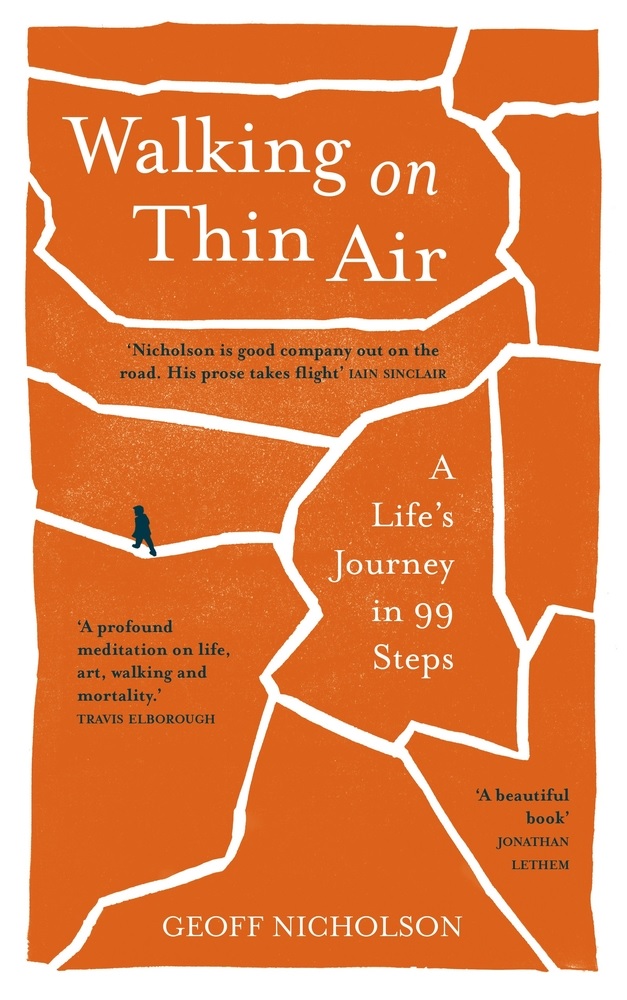 British author Geoff Nicholson, "whose work examined the links between emotions, behavior, and location, notably in his novel Bleeding London," died January 18 at age 71, the Guardian reported. In 2014, Londoners and visitors were asked to follow the book's main character Stuart London and walk the entire 58,000 streets of the London A to Z atlas. An exhibition was later held at City Hall and prompted imitation by camera enthusiasts elsewhere in Europe.
British author Geoff Nicholson, "whose work examined the links between emotions, behavior, and location, notably in his novel Bleeding London," died January 18 at age 71, the Guardian reported. In 2014, Londoners and visitors were asked to follow the book's main character Stuart London and walk the entire 58,000 streets of the London A to Z atlas. An exhibition was later held at City Hall and prompted imitation by camera enthusiasts elsewhere in Europe.
Nicholson published 17 novels, 10 works of nonfiction, many short stories and anthology contributions, and several popular blogs. "His surreal, complex and sometimes transgressive comedies were only erratically successful from a commercial point of view," though his third novel, What We Did on Our Holidays, was adapted into the 2007 film Permanent Vacation.
His early books include Street Sleeper, Bedlam Burning, and Day Trips to the Desert, but Nicholson "did not capitalize on these early successes and remained... something of an outsider, at least in the U.K. But his work attracted a cult following, nowhere more so than in Los Angeles, where he lived and worked between 2006 and 2018," the Guardian noted. Other works include Footsucker and Sex Collectors, but as he got older, Nicholson turned his attention to walking, the theme of five of his last eight published works.
Shortly after he returned to Britain in 2018, Nicholson was diagnosed with a rare blood cancer. For the most part it was controlled and he "went out walking, every day, padding streets near and far. Always armed with a camera, he did his research, took photos, picked up items of interest--an unusually colored rock, a discarded magazine or an item in a junk shop that took his eye," the Guardian wrote. These observations found their way into The Suburbanist (2021).
In his final work, Walking on Thin Air: A Life's Journey in 99 Steps (2023), he wrote "candidly about his illness, although it was more a celebration of life than of mortality," the Guardian noted. "He did not expect this to be his swansong, but proved to be a prophetic subtitle."
| Advertisement Meet belle bear! |


